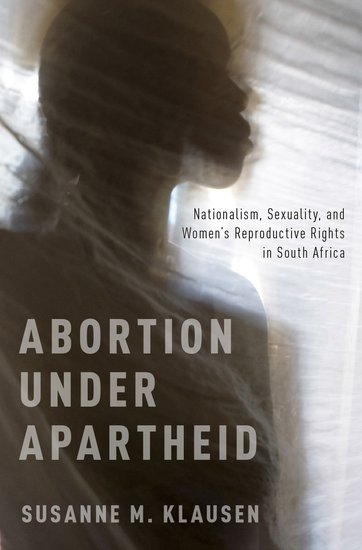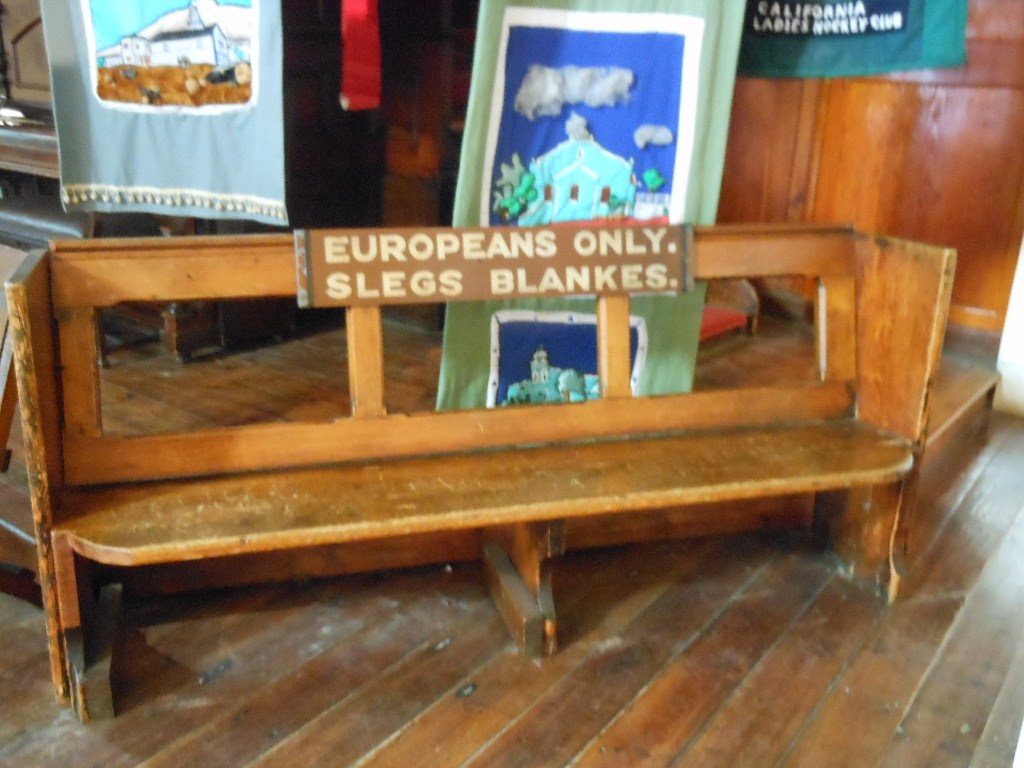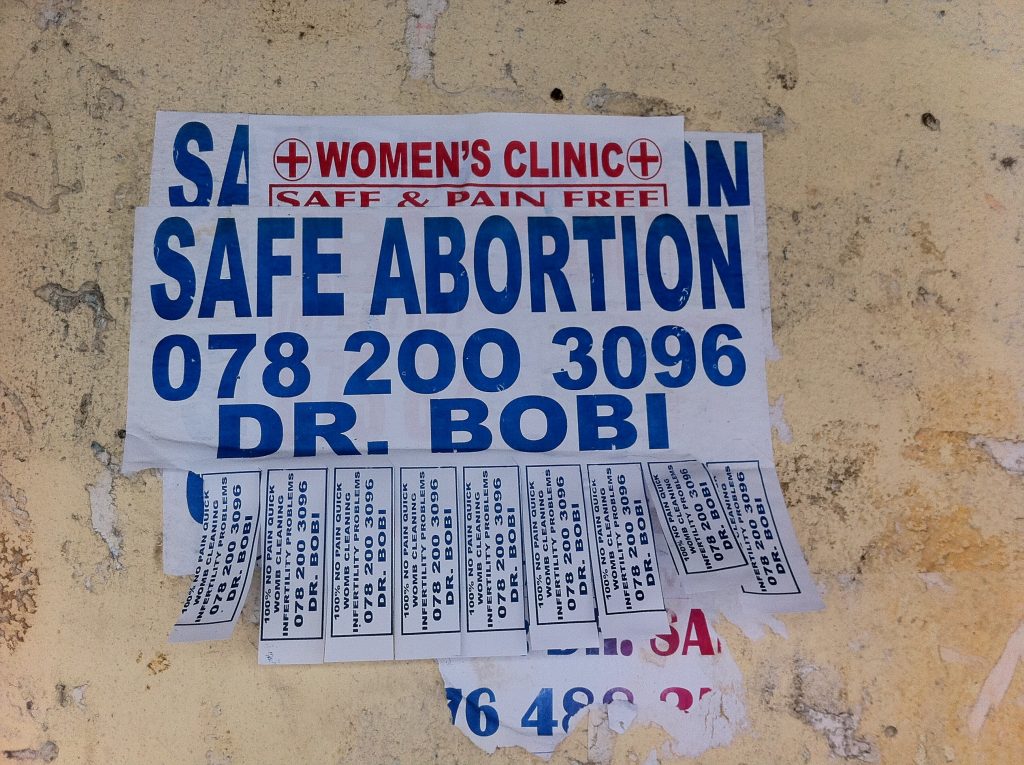Interview by Nicole Bourbonnais
In her groundbreaking book, Abortion Under Apartheid: Nationalism, Sexuality, and Women’s Reproductive Rights in South Africa, Susanne Klausen tells the story of ongoing attempts to regulate women’s sexuality in apartheid-era South Africa (1948-1990). During these decades, women of all races and ages faced barriers when choosing to end a pregnancy. Klausen carefully teases out the impact of race in shaping the distinct experiences of black and white women who sought abortions, during a period in which the ruling Afrikaner National Party aimed, above all else, to preserve the existing system of white supremacy.
The winner of the Canadian Committee on Women’s History’s award for the best book published in Women’s and Gender History, and the Joel Gregory Prize for the best work published in African Studies, Klausen’s study is the first scholarly monograph on the history of abortion in any African country. Offering an insightful analysis of legal and hospital records, as well as new interviews with key actors who were directly impacted by the criminalization of abortion, Abortion Under Apartheid demonstrates that the regulation of women’s reproductive bodies was central to the making and maintenance of apartheid in South Africa.

Nicole Bourbonnais: The subject of abortion came up occasionally in your first book, Race, Maternity, and the Politics of Birth Control in South Africa, 1910-39, which focused primarily on early efforts to distribute contraceptives like the diaphragm and sponge. What inspired you to dedicate a full book to abortion, and to focus specifically on the apartheid period?
Susanne Klausen: I’ve had a strong interest in the history and politics of abortion since the late 1980s, when I joined the national movement in Canada, where I’m from, to keep abortion from being re-criminalized after our Supreme Court struck down the existing law on abortion. It was such an exciting experience, not least because we ultimately won the fight to prevent re-criminalization, which means that today abortion is considered only a medical issue. I was an undergraduate student at the time, and my involvement in that struggle taught me a great deal about the kind of world I want to live in. The leaders of the movement, at least the ones I followed, were international socialists, and although I don’t think they ever used the word “intersectionality,” I remember how they linked the fight for accessible abortion to a broader, more radical struggle for social justice by affirming, for example, the rights of gays and lesbians to be respected, and condemning racism and poverty.
In addition, of course, I learned about the humiliating, even dangerous, abortions girls and women around the world are forced to undergo when they live in countries that refuse to respect our right as women to control our fertility. So I decided going forward to combine my love of studying history and my conviction that girls and women should never be forced to become mothers or risk their lives to end unwanted pregnancies.
When I was a doctoral student, I focused on the emergence of the birth-control movement in South Africa in the 1930s and initially I expected abortion would be part of that story. But as I began to dig around in the archives, I realized that the birth-control movement in South Africa, like in so many places, didn’t want to be associated with the controversial issue of abortion, which was criminalized and stigmatized; it wanted to attain respectability in order to secure state funding for birth-control clinics, which it did manage to do in the 1930s. So clandestine abortion did not figure much in my doctoral thesis, which ultimately became my first book.
But I knew that for my next study I wanted to focus exclusively on abortion in South Africa because I was certain there would be an important story to unearth. Historians had already shown us that women around the world find ways to terminate unwanted pregnancies, so South African women would obviously also have done so. Moreover, feminist historian Helen Bradford, now retired from the University of Cape Town, wrote a brilliant essay in the early 1990s about clandestine abortion in South Africa during the 19th and 20th centuries and I found it absolutely riveting. So I set out, with my second project, to build on her important initial research.
I started the research in 2005 and the decision to focus on the apartheid era (1948-1990) was purely pragmatic: it was during those decades that abortion became a highly politicized and public issue, and the first statutory legislation on abortion was passed in 1975, so those were the years about which I could find documentation and key individuals to interview. Importantly, groups such as the liberal feminist Abortion Reform Action Group (ARAG), that advocated abortion law reform in the 1970s and 1980s, had donated their papers to various archives, which left a rich paper trail that is non-existent for previous decades.
NB: As we would expect, the story of abortion under apartheid is heavily inflected with racial politics. But your book points out that it is also very much about the National Party’s desire to impose a conservative, puritanical vision of sexual morality on South African society during a time of social change. How do race and sexuality intersect with one another to shape abortion politics during this period?
SK: Given how racist South Africa was, I was initially surprised by how little the ruling National Party was interested in black women’s attempts to procure abortion. I started the project assuming the National Party, which was the political embodiment of the white-supremacist Afrikaner nationalist movement, would have wanted black women to have access to medical abortion. I made this assumption because of the government’s, and whites’ in general, great fear of black population growth that long predated the National Party’s ascension to power in 1948 and the implementation of apartheid. Since the formation of South Africa in 1910, the white minority was anxious about the threat of “swamping” by the larger black majority. So I expected, naively I now realize, that the National Party would not wish to impede in any way black women’s evident desire to procure abortions – as shown by the large numbers of black girls and women streaming into hospital emergency wards in cities around the country for help with incomplete or botched abortions beginning in the 1960s.
Instead, the government was totally preoccupied with white girls’ and young unmarried women’s efforts to terminate unwanted pregnancies. I realized the regime was obsessed with buttressing white supremacy by maintaining whites’ putative moral superiority; the white race, it was repeatedly stated, was more “civilized” than “barbarous” Africans. When the regime realized in the early 1970s that young white women were rejecting patriarchal authority by engaging in “sinful” pre-marital sex and “evading the consequence” of motherhood by procuring abortions, it saw this as further evidence that whites’ moral fiber was weakening. This was a source of great anxiety at a time when the Cold War was raging and South Africa was supposedly a target of international communist attack. Leaders of the National Party truly believed that a morally weak white race, already numerically weak relative to blacks, would be unable to withstand attack by communists outside the country and by African nationalists from within. So the regime’s attempt to cut off white girls’ and women’s access to safe, medical abortion was part and parcel of the struggle to ward off white South Africa’s enemies by maintaining the moral purity of the race. This was a pipe dream, of course, but one the white political elite took very seriously.
NB: At various points, actors from all sides of the debate make reference to events and policies in other countries, such as the rise of women’s liberation movements in the West, abortion laws in countries from Britain to Japan, and African anti-colonial movements. How does the international context play into the story?
SK: The international context is absolutely fundamental to the direction taken by so many of the groups that had a stake in the battle over the meaning of and access to abortion during the apartheid era. From the medical and legal professions to the self-proclaimed pro-choice movement and the government, developments elsewhere in Africa and beyond were sources of inspiration or fear, depending on a group’s political position.
For example, the wave of decolonization sweeping across the African continent starting in 1957, when Ghana became the first country to win independence from colonial rule, was a source of tremendous anxiety for whites in South Africa committed to maintaining the white supremacist economic, social, political, and spatial system that was apartheid. So was the friendly relationship between some of the decolonization movements and the Soviet Union.

At the same time, movements for abortion law reform in numerous countries were succeeding at liberalizing their abortion laws, starting with Britain’s passage of the 1967 Abortion Act, an intensely inspiring development for advocates of abortion law reform in dozens of countries around the world, including South Africa. For example, ARAG, which for years fought the government’s retrograde attitude towards women and abortion, joined the British Abortion Law Reform Association in the mid-1970s in order to gain a morale boost and greater access to knowledge about international developments. During the years of debate over what the first statutory law on abortion should look like, which culminated with the passage of the extremely restrictive Abortion and Sterilisation Act in 1975, you see actors on all sides referring to developments beyond South Africa’s borders in attempts to support their position.
In recent years South Africanist historians have taken seriously the need to place the country’s national history in a transnational context. When I set out to understand what was going on in relation to abortion in South Africa during the apartheid era, I was aware of the growing trend in our discipline to identify the transnational circulation of ideas, technologies, and people, but I was quite surprised by just how important it was to the story.
NB: Although some local women’s groups do intervene during this period, calling for access to abortion on explicitly feminist grounds, you note that their efforts made limited headway without the support of a broader-based women’s movement. Instead, most of the advocates for abortion law reform we see here are the doctors and lay practitioners who were faced daily with women suffering complications from unsafe self-induced or backstreet abortions (which made up a shockingly high number of admissions to hospital wards during this period). Some of these practitioners seem motivated by liberal ideology, others by basic sympathy for their patient’s struggles, still others by a desire to protect themselves from the potential legal repercussions of performing or completing an illegal abortion. Do you think the motivations and ideological orientation of these different actors mattered, and if so, how?
SK: I think there is more than one answer to the question, depending on the time span you apply. During the apartheid era there were very few South Africans who dared to publicly demand accessible medical abortion services for girls and women of all racial categories. As I show in the book, there were some fearless feminists and doctors who did, but they stood out at the time as exceptional. Most South Africans, white and black, either disapproved of abortion except, perhaps, to save a woman’s life, or else were too politically timid or isolated to publicly challenge sexist attitudes about women’s reproductive sexuality. ARAG, the group of white feminists that bravely and tenaciously tried to reform the abortion law in the 1970s and 1980s, ultimately was unable to attract widespread support. In the context of such an extremely patriarchal and racially segregated society, ARAG was too radical to attract many white women and too white and middle class to appeal to black women, so it remained small and ultimately ineffective. But even if many advocates of law reform had united to demand the ruling National Party pass a liberal abortion law, they would have failed. The regime was intensely patriarchal, puritanical, authoritarian, and hostile to the concept of accessible abortion as well as to the feminists and liberals who criticized the government’s stance on abortion. And there was no opposition political party committed to women’s right to control their fertility strong enough to challenge National Party rule. So there was no way the National Party would allow the passage of a liberal law.
However, with the benefit of hindsight, I think a strong united front of advocates demanding accessible abortion in feminist terms could have had a positive effect in the longer term. Abortion is still a stigmatized, controversial issue in South Africa, and what is needed is a radical shift in the national culture’s attitude towards women and gender equality. The feminist activists who realized this back in the 1970s were too few in number, and sometimes detached from broader struggles for social justice, to make a significant impact on patriarchal public perceptions of women’s sexuality and reproductive rights. But if they had been joined in their condemnation of the status quo by more members of the legal, nursing, and medical professions, and of political opposition parties who were also appalled by the effects of clandestine abortion, then deep-rooted sexist attitudes could have been challenged far more forcefully. Perhaps that might have cultivated greater public acceptance for demands for gender justice made by South African feminists in the post-apartheid era.
NB: Beyond exploring the political arena, your book also provides us with a window into the experience of abortion, documenting the great challenges, health risks, and emotional abuse women often faced in their efforts to obtain what could have otherwise been a straightforward and safe procedure. Although you combine a range of sources (including court transcripts, medical records, interviews with providers, and newspaper articles) to tell this aspect of the story, one of the most powerful descriptions is found in a passage from Zoe Wicomb’s novel You Can’t Get Lost in Cape Town. What made you include that passage, despite the fact that it is obviously fictional? What role do you think fiction can play in historical writing?
SK: As you can imagine, very few of the girls and women who underwent a clandestine abortion wanted to publicly discuss the experience or left behind papers that describe in their own words what they went through. Because of the stigma associated with abortion, and the fear of shaming that would ensue if “found out,” most women tried desperately to hide the fact they’d had abortions. Indeed, it was the fear of being caught that forced so many of them to take their chances with untrained but discreet abortionists.
But one of my book’s main goals is to convey what poor and working-class young women – black and white – actually went through. Unlike white middle-class teenagers and women, the vast majority of South African women didn’t have the money to fly to London or Lourenço Marques to have a safe abortion in a private clinic. Instead, black women and working-class white women turned to abortion providers willing to break the law, normally for a fee. While, as I show in the book, some medical and self-taught abortionists were extremely diligent and caring, many were simply unskilled and dangerous. And I think it is crucial that we know just how terrifying and often painful it was to be forced to have a clandestine abortion. Yet I didn’t want to approach women who, decades ago, had illegal abortions and ask them to recall in detail their awful experiences if it wasn’t necessary. I found that there were already enough glimpses into what they experienced in autobiographies, trial transcripts, newspaper accounts, and novels to make it possible to use their own words to recount events and their feelings about them.
Novels, of course, are great for conveying our inner lives, our intimate thoughts and subjectivities, especially when it comes to so-called ordinary people who usually don’t leave records behind. But I think I have a responsibility to use texts whose authors are combining their imagination and artistry with knowledge of how things were in the past. Zoe Wicomb is one such writer. I, too, was impressed by her powerful description of a woman’s horrible experience procuring an illegal abortion from a racist white woman, but before I included it in my book I contact her by email to ask her about it. Wonderfully, she quickly answered, telling me that the passage was based on the experience of a friend of hers who had told her about it. That was enough for me. I also contacted Kagiso Molope to ask about the passages on clandestine abortion in her terrific novel, Dancing in the Dust, about a Sesotho girl growing up in the 1970s in a township outside Pretoria, and she told me the same thing: she based those passages on stories she heard from girls who had had such experiences. More broadly, for insight about what it was like for girls to grow up during apartheid, I found memoirs by the singer Miriam Makeba and anti-apartheid activist Mamphela Ramphele very helpful; the latter’s account of getting her period, which she found frightening, and being told in cryptic terms to stay away from boys, is very moving and induces feelings of great compassion in the reader.
NB: Throughout the book we see many of the same tropes repeated over and over (that women who obtain abortions are irresponsible or sexually immoral, that women who claim to have been raped can’t be trusted, that abortion is a form of “race suicide,” etc.). These tropes continue to be used as justification for restricting access to abortion by various states around the world today. As you argue in the conclusion, the stigma surrounding abortion also continues to keep many women away from state health facilities in South Africa, despite the liberalization of the abortion law by the post-apartheid regime. Is it frustrating to write about a subject that brings to view such callous attitudes towards women and that seems to make so little headway in practice? Do you see any silver linings or promising ways forward in this field, in South Africa or elsewhere?
SK: There have been moments during the past ten years when I felt incredibly angry about the sexist, at times misogynistic, attitude towards women who wanted to control their fertility that was commonplace in apartheid culture. For example, at one point in the final debate about the Abortion and Sterilisation Bill that took place in Parliament in 1975 just before its passage into law, one member of the National Party actually told an incredibly disgusting rape joke in Parliament. And during the trials of some abortionists, young women forced to give testimony in return for immunity from prosecution were completely humiliated in public. I decided early on that the best way to deal with reading such things was to hang on to my anger and tap into it for motivation to work harder to convey to readers just how incredibly sexist South African society was during the apartheid era, something that is often forgotten, or at least sidelined, in historical analyses that continue to focus primarily on its racism.
And it is indeed beyond frustrating to see the ongoing stigmatization of abortion in South Africa today, and the negative effects it has on women, especially black teenagers. So many of us who believe women should have access to safe abortions provided in a respectful environment were jubilant when, in 1996, the newly elected African National Congress (ANC) government passed the Choice on Termination of Pregnancy Act, one of the most liberal abortion laws in the world. The ANC passed the new law because of pressure to do so from feminists located inside the party and in civil society organizations pushing the ANC from the outside. The new law essentially permits abortion on demand, and there was such a sense of hope that its passage would initiate a new era of respect for women’s reproductive rights and put an end to the abusive practices that were rife in the medical system.
But many people, myself included, hugely underestimated the incredibly powerful grip of patriarchal attitudes towards women in South African society. Abortion is still very stigmatized, and members of the nursing and medical professions continue to display a judgmental attitude towards teenagers and women needing abortions. Many simply refuse to perform the procedure. Consequently, many women simply avoid public health facilities and – just like in the apartheid era – turn to the clandestine abortion industry, which continues to thrive. Additionally, the health department and the ANC itself do too little to ensure accessibility to abortion services in public health facilities. When it comes to abortion and other gender justice issues in the “new” South Africa, the law may have changed radically, but dominant notions about the correctness of women’s subordination to men have continued to thrive. The struggle for reproductive justice has a long way to go.

This situation is not unique to South Africa or the African continent. I remember how truly ill I felt last year, for example, when I heard the news about an 11-year-old girl in Paraguay who became pregnant after her step-father allegedly raped her, and was denied an abortion. She actually was forced to become a mother, something that is simply horrifying and unacceptable. On the bright side – and let’s end this discussion on a happy note – there are fantastic individuals and organizations, such as the Sexual and Reproductive Justice Coalition and the End Abortion Stigma Initiative, that are fighting for reproductive justice in South Africa, as elsewhere. The feminists in groups like these, who network with women’s health advocates across Africa and around the world, are fiercely committed to ending abortion stigma and transforming the public’s attitude towards women’s sexual and reproductive rights. They are brave, tenacious and tremendously inspiring, and I cheer them on from Canada.

Susanne Klausen is Associate Professor in the Department of History at Carleton University, Ottawa. Her main areas of research are nationalism and sexuality, politics of fertility in modern South Africa, and movements for reproductive rights in a transnational perspective. Her teaching subjects include ancient and modern African history, medical history, and gender and sexuality in a transnational context. She received her PhD in History from Queen’s University at Kingston in 1999, and her doctoral research was the basis of her first book, Race, Maternity, and the Politics of Birth Control in South Africa (Houndmills, U.K.: Palgrave Macmillan, 2004). She has published in South African, Canadian, British and American journals.

Nicole Bourbonnais is an Assistant Professor of History at the Graduate Institute of International and Development Studies in Geneva, Switzerland. Her first book, Birth Control in the Decolonizing Caribbean: Reproductive Politics and Practice on Four Islands, 1930-70 (forthcoming, Cambridge University Press), traces the creation of birth control clinics and state population policy in Jamaica, Trinidad, Barbados and Bermuda. She is currently working on a manuscript exploring global family planning activism in the mid-20th century.

NOTCHES: (re)marks on the history of sexuality is licensed under a Creative Commons Attribution-NonCommercial-NoDerivatives 4.0 International License.
Based on a work at www.notchesblog.com.
For permission to publish any NOTCHES post in whole or in part please contact the editors at NotchesBlog@gmail.com





One Comment